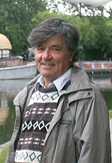- The Resistive Capacitor (2012) [Updated 1 decade ago]
- What Happened to Electromagnetic Theory (2012) [Updated 1 decade ago]
- The End of Electric Charge and Electric Current as We Know Them, Part 1 (2011) [Updated 1 decade ago]
- The End of Electric Charge and Electric Current as We Know Them, Part 2 (2011) [Updated 1 decade ago]
- Does Faraday Allow Superposition? (2011) [Updated 1 decade ago]
- A Difficulty in Electromagnetic Theory (1998) [Updated 1 decade ago]
- The Conquest of Truth (1988) [Updated 1 decade ago]
- The Conquest of Thought (1987) [Updated 1 decade ago]
- Fundamentals of Electromagnetic Energy Transfer (1984) [Updated 1 decade ago]
- The Death of Electric Current (1982) [Updated 1 decade ago]
- Maxwell's Equations Revisited (1980) [Updated 1 decade ago]
- The History of Displacement Current (1979) [Updated 1 decade ago]
- The Heaviside Signal (1979) [Updated 1 decade ago]
- The Two T.E.M. Signals (1978) [Updated 1 decade ago]
- The Rise and Fall of Bodies of Knowledge (1978) [Updated 1 decade ago]
- Displacement Current (1978) [Updated 1 decade ago]
- Signal Transmission in Digital (1969) [Updated 1 decade ago]
- Crosstalk (Noise) in Digital Systems (1967) [Updated 1 decade ago]
- The Transverse Electromagnetic Wave. A TEM Step
- The Catt Question
- The Resistive Capacitor (2012) [Updated 1 decade ago]
"It isn't what we don't know that gives us trouble, it's what we know that ain't so." ? Will Rogers
- What Happened to Electromagnetic Theory (2012) [Updated 1 decade ago]
For 40 years I thought that the problem at the centre of classical electromagnetism arose in around 1890, when Heaviside showed that he was unsure about how to choose between two contradictory models for the Transverse Electromagnetic Wave. Although I quote him as backing ?The Heaviside Signal? [4], the truth is that he vacillated between the two. However, recently I realized that the problem of misinterpretation of experimental results arose much earlier, with Faraday in 1831.
- The End of Electric Charge and Electric Current as We Know Them, Part 1 (2011) [Updated 1 decade ago]
For 43 years it has not been noticed, even by the author, that oscilloscope pictures (reproduced here) undermine the concepts of electric charge and electric current, and with them a large part of 20th century scientific theory. We see two electric currents traveling in opposite directions downa single conductor. Conventional electric current is not fit for the purpose...
- The End of Electric Charge and Electric Current as We Know Them, Part 2 (2011) [Updated 1 decade ago]
Last month, a narrow voltage spike was injected into a printed circuit conductor above a ground plane in the presence of a parallel passive line. Further down the lines it separated out into the faster Odd Mode and the slower Even Mode. Last month I proved mathematically that the earliest, first traces wer not permissible under Faraday's Law...
- Does Faraday Allow Superposition? (2011) [Updated 1 decade ago]
The speed of an electric current has always been a matter for discussion. This went nowhere while it was not realized that the energy delivered from a battery to a lamp traveled at the speed of light. Traditionally, it involved both electricity and traveling field. Linking this with the idea that electrons traveling at the speed of light would have infinite mass, a crisis for electricity which became clearer with the advent the pulses in digital electronics was evaded for the next half century. Ever more glaring flaws in this misalliance in classical electromagnetism were pointed out during the last thirty years and ignored, culminating in the present very clear, simple exegesis, where two fields of opposite polarity travel together, one with current in one direction down each wire, superposed with the other with current in the opposite direction down the same wire.
- A Difficulty in Electromagnetic Theory (1998) [Updated 1 decade ago]
Presented to and published by the Institution of Electrical Engineers, Professional Group D7 (History of Technology), 26th Weekend Meeting, 10?12 July 1998, University of East Anglia, publication HEE/26
- The Conquest of Truth (1988) [Updated 1 decade ago]
- The Conquest of Thought (1987) [Updated 1 decade ago]
- Fundamentals of Electromagnetic Energy Transfer (1984) [Updated 1 decade ago]
Discussion of some weaknesses in the traditional approach to e.m. theory, and the establishment of a sounder foundation
- The Death of Electric Current (1982) [Updated 1 decade ago]
A major advance in electromagnetic theory, which I shall call the transition from Theory N to Theory H, was made by Oliver Heaviside a century ago. What is proposed here is a transition from Theory H to a third theory, Theory C. It is to be hoped that the response to Theory C will be more perceptive than was the general response to Theory H a century ago?
- Maxwell's Equations Revisited (1980) [Updated 1 decade ago]
- The History of Displacement Current (1979) [Updated 1 decade ago]
- The Heaviside Signal (1979) [Updated 1 decade ago]
- The Two T.E.M. Signals (1978) [Updated 1 decade ago]
IEEE Computer Society, 1978, OCLC 35349268
- The Rise and Fall of Bodies of Knowledge (1978) [Updated 1 decade ago]
The Information Scientist, 12 (4) December 1978, pp. 137?144
- Displacement Current (1978) [Updated 1 decade ago]
- Signal Transmission in Digital (1969) [Updated 1 decade ago]
Micro Magazine (July 1969) All the literature treats a transmission line as a series of infinitesimally small inductors and capacitors; this article presents the more realistic approach where at no time do we have to consider infinitesimally small segments of the line.
- Crosstalk (Noise) in Digital Systems (1967) [Updated 1 decade ago]
IEEE Trans. Elect. Comp. 16 (6): 743-763 (1967)
- The Transverse Electromagnetic Wave. A TEM Step
- The Catt Question



